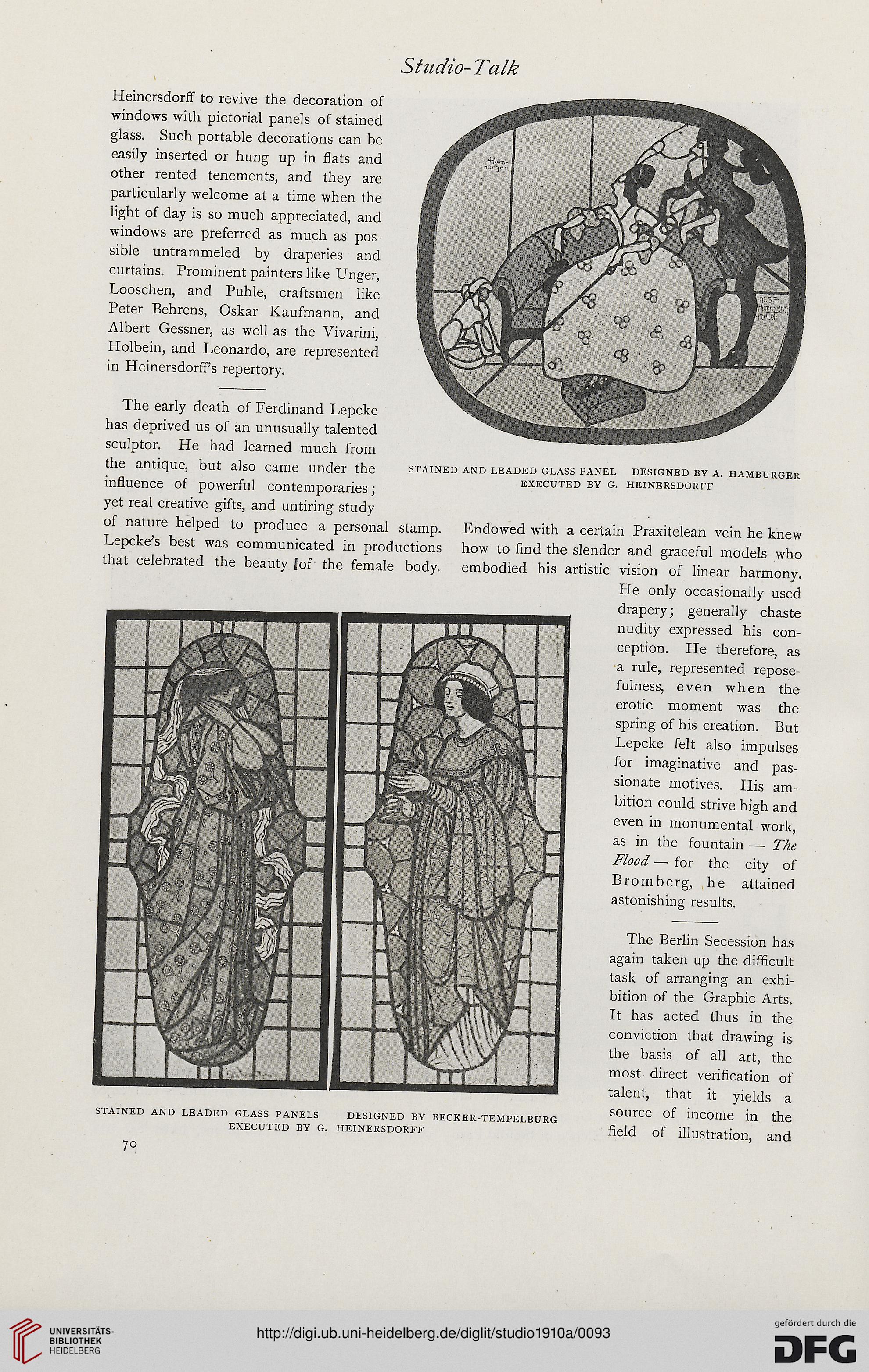Studio-Talk
Heinersdorff to revive the decoration of
windows with pictorial panels of stained
glass. Such portable decorations can be
easily inserted or hung up in flats and
other rented tenements, and they are
particularly welcome at a time when the
light of day is so much appreciated, and
windows are preferred as much as pos-
sible untrammeled by draperies and
curtains. Prominent painters like Unger,
Looschen, and Puhle, craftsmen like
Peter Behrens, Oskar Kaufmann, and
Albert Gessner, as well as the Vivarini,
Holbein, and Leonardo, are represented
in HeinersdorfFs repertory.
The early death of Ferdinand Lepcke
has deprived us of an unusually talented
sculptor. He had learned much from
the antique, but also came under the stains
influence of powerful contemporaries;
yet real creative gifts, and untiring study
of nature helped to produce a personal stamp.
Lepcke’s best was communicated in productions
that celebrated the beauty [of the female body.
i and leaded glass tanel designed by a. hamburger
EXECUTED BY G. HEINERSDORFF
Endowed with a certain Praxitelean vein he knew
how to find the slender and graceful models who
embodied his artistic vision of linear harmony.
He only occasionally used
drapery; generally chaste
nudity expressed his con-
ception. He therefore, as
a rule, represented repose-
fulness, even when the
erotic moment was the
spring of his creation. But
Lepcke felt also impulses
for imaginative and pas-
sionate motives. His am-
bition could strive high and
even in monumental work,
as in the fountain — The
Flood — for the city of
Bromberg, he attained
astonishing results.
stained and leaded glass panels designed by becker-tempelburg
EXECUTED BY G. HEINERSDORFF
The Berlin Secession has
again taken up the difficult
task of arranging an exhi-
bition of the Graphic Arts.
It has acted thus in the
conviction that drawing is
the basis of all art, the
most direct verification of
talent, that it yields a
source of income in the
field of illustration, and
70
Heinersdorff to revive the decoration of
windows with pictorial panels of stained
glass. Such portable decorations can be
easily inserted or hung up in flats and
other rented tenements, and they are
particularly welcome at a time when the
light of day is so much appreciated, and
windows are preferred as much as pos-
sible untrammeled by draperies and
curtains. Prominent painters like Unger,
Looschen, and Puhle, craftsmen like
Peter Behrens, Oskar Kaufmann, and
Albert Gessner, as well as the Vivarini,
Holbein, and Leonardo, are represented
in HeinersdorfFs repertory.
The early death of Ferdinand Lepcke
has deprived us of an unusually talented
sculptor. He had learned much from
the antique, but also came under the stains
influence of powerful contemporaries;
yet real creative gifts, and untiring study
of nature helped to produce a personal stamp.
Lepcke’s best was communicated in productions
that celebrated the beauty [of the female body.
i and leaded glass tanel designed by a. hamburger
EXECUTED BY G. HEINERSDORFF
Endowed with a certain Praxitelean vein he knew
how to find the slender and graceful models who
embodied his artistic vision of linear harmony.
He only occasionally used
drapery; generally chaste
nudity expressed his con-
ception. He therefore, as
a rule, represented repose-
fulness, even when the
erotic moment was the
spring of his creation. But
Lepcke felt also impulses
for imaginative and pas-
sionate motives. His am-
bition could strive high and
even in monumental work,
as in the fountain — The
Flood — for the city of
Bromberg, he attained
astonishing results.
stained and leaded glass panels designed by becker-tempelburg
EXECUTED BY G. HEINERSDORFF
The Berlin Secession has
again taken up the difficult
task of arranging an exhi-
bition of the Graphic Arts.
It has acted thus in the
conviction that drawing is
the basis of all art, the
most direct verification of
talent, that it yields a
source of income in the
field of illustration, and
70




